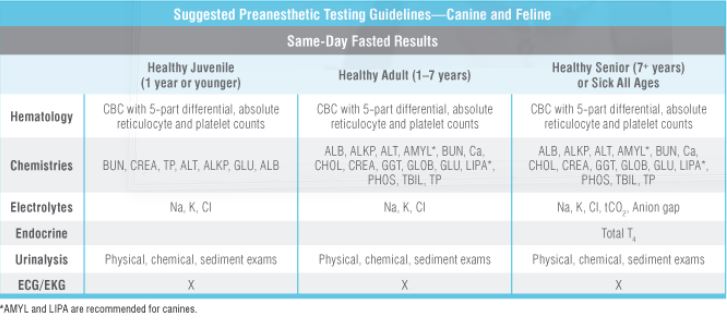Preanaesthetic Testing: Don’t compromise—change happens fast
Ensure safer anaesthetic events with real-time blood-work results
You always do a physical exam on the day of surgery. So why wouldn’t you also perform same-day, preanaesthetic blood work to minimise your patients’ anaesthetic risk?
Same-day, real-time blood work results decrease the risk of serious complications during induction, anaesthesia and recovery.

Benefits
Ensure your patients’ safety with same-day results
- The complete blood count (CBC) is a more sensitive indicator of disease than the physical exam.
- Screen for conditions such as thrombocytopaenia and anaemia that may greatly enhance the risk of anaesthetic and surgical procedures.
- Running a CBC the day of the procedure is critical, because cellular components can change quickly. For example, red blood cells (RBCs) can change in just a few minutes if an occult mass ruptures or in just hours with an occult haemorrhage.
- Additionally, white blood cells (WBCs) and platelets can change within hours due to acute infectious diseases.
- Abnormal glucose levels can increase anaesthetic risk and differ markedly between fasted and nonfasted samples, breeds, age and sick and healthy patients.
- Evaluating electrolytes, haematocrit and total protein in fasted patients is essential for monitoring during anaesthesia, minimising the risk of arrhythmias and hypotension and facilitating patient recovery.
- Same-day testing allows owners to fast pets only once. It’s easier on pets and owners and increases compliance.
Don’t rely on yesterday’s news to make decisions today
Many laboratory tests, especially the complete blood count (CBC) and glucose, are affected by time, environmental stress and fasting. Same-day in-house testing on fasted samples ensures accurate, immediate results.
Tailor your anaesthetic protocols to enhance your monitoring potential and make fluid therapy and pain medication choices based on individual results
- Preanaesthetic testing serves as an invaluable baseline for referencing and interpreting future blood work.
- Accurate laboratory results are technology dependent, so it makes sense to establish baselines on the same instrument you’ll use for future blood work or emergencies.
Same-day blood work lets you deliver clients information today for more convenience and better compliance.
Protocols/Implementation

Implement consistent, thorough preanaesthetic protocols
Share the benefits of a comprehensive preanaesthetic program with your clients, your staff and, most important, your patients.
The following are suggested preanaesthetic testing guidelines to help you establish a practice protocol.
- A comprehensive baseline allows you to trend values throughout a patient’s life to detect even subtle changes that could be clinically significant.
Albumin levels that are low or low-normal can indicate serious disease and are very important in gauging an animal’s hydration status as well as fluid therapy choices and rates.
- In geriatric patients with cancers, such as lymphosarcoma or anal sac carcinomas, calcium is often the only elevated analyte. Elevated TBIL and/or phosphorous levels can indicate renal and/or hepatic disease
Five simple steps to implementation
Eliminate confusion for your staff and clients and simplify your work flow by posting guidelines stating which preanaesthetic tests you will run on which patients.
- Update templates and create computer codes so that surgical procedures requiring anaesthetics include preanaesthetic testing.
- Computer codes help avoid lost charges: You’ll easily see if preanaesthetic testing was charged when you prepare an invoice for surgery or dentistry.
Put your preanaesthetic testing protocols to work. Knowing that you’re doing the best for your patients will increase your confidence—and your clients’ confidence too.
Run a report to identify the number of preanaesthetic procedures that have been done and if they have followed your new protocols.
Tools/Resources
Tools and tips for a strong preanaesthetic program
Add a CBC to your preanaesthetic testing protocol
Preanesthetic Testing: It's Time to Broaden Your Coverage
How to Integrate Preanesthetic Testing into Your Practice
Get Clients to Say "YES!" to Preanesthetic Testing
Help Avoid Anesthetic Complications—Run a CBC on Every Preanesthetic Patient
Do Tests First: Pre-surgical Blood Work May Eliminate a Variety of Surprises
Tools to share for better client education and compliance
Get the Whole Picture: Diagnostic Wheel
Get the Whole Picture: Diagnostic Wheel